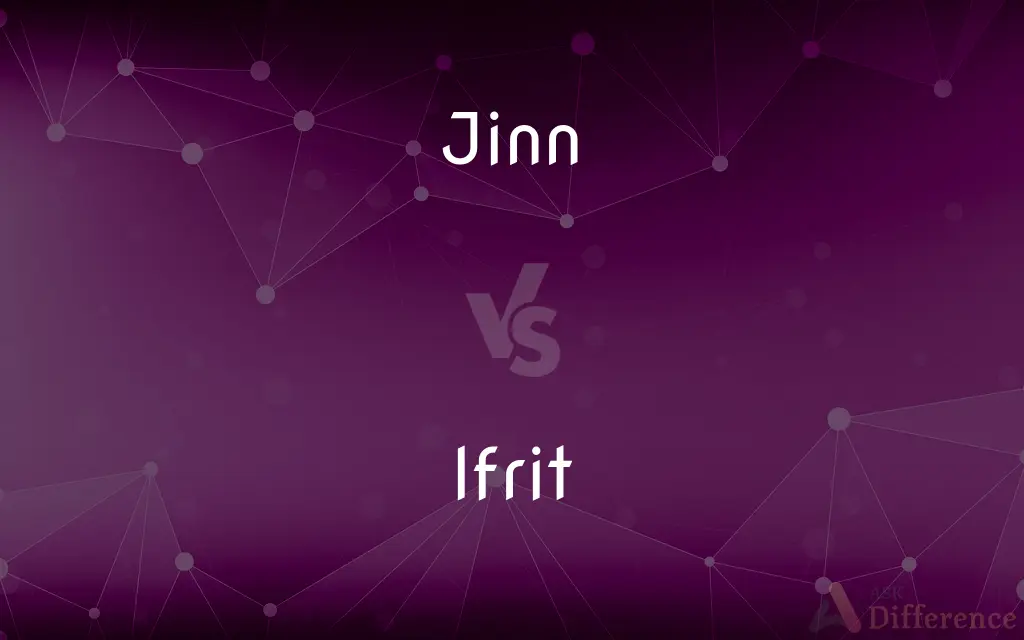Jinn vs. Ifrit — What's the Difference?
By Fiza Rafique & Maham Liaqat — Updated on March 29, 2024
Jinn are supernatural beings in Islamic and Arabian folklore, capable of shape-shifting and influencing humans, while Ifrits are a powerful and rebellious class of jinn known for their strength and malevolence.

Difference Between Jinn and Ifrit
Table of Contents
ADVERTISEMENT
Key Differences
Ifrits, on the other hand, are often depicted as a subclass of jinn within Islamic mythology, characterized by their great strength and aggressive demeanor. Jinn have been a subject of fascination and intrigue in various cultures, leading to numerous folk tales and myths that emphasize their ability to shape-shift, become invisible, or possess individuals.
Ifrits, while possessing similar shape-shifting abilities, are often portrayed in stories as preferring forms that reflect their fiery origin and intimidating strength. Jinn, in folklore, are not inherently evil or good; their actions towards humans are influenced by their own personalities and choices, similar to humans.
Ifrits, however, are predominantly depicted as malevolent, with few stories portraying them in a positive light. Jinn, according to Islamic and Arabian folklore, are invisible entities created from smokeless fire, possessing free will to do good or evil.
Comparison Chart
Origin
Created from smokeless fire
A powerful class of jinn, also from fire
Nature
Can be good, evil, or neutral
Generally malevolent and rebellious
ADVERTISEMENT
Abilities
Shape-shifting, invisibility, possession
Similar abilities, but often associated with strength and fire
Depictions
Vary widely; can be benevolent or malevolent
Often depicted as fearsome and powerful
Role in Stories
Diverse roles, from helpers to antagonists
Usually antagonists, embodying chaos and destruction
Compare with Definitions
Jinn
Supernatural beings from Islamic mythology, created from smokeless fire.
The old tales speak of jinn living alongside humans, unseen.
Ifrit
Associated with tales of magic and danger.
In the story, an ifrit guards the ancient treasure with fierce loyalty.
Jinn
Known for their ability to shape-shift.
The jinn assumed the form of a human to walk among us.
Ifrit
Often depicted as malevolent.
An ifrit was blamed for the series of misfortunes plaguing the town.
Jinn
Capable of possessing and influencing humans.
People believed the sudden illness was caused by a jinn.
Ifrit
Known for their strength and connection to fire.
The ifrit emerged from the flames, its form towering and fierce.
Jinn
Live in a parallel world to humans.
Jinn have their own societies, unseen by human eyes.
Ifrit
Portrayed with fearsome appearances.
The ifrit’s appearance was so terrifying that it froze the hero in place.
Jinn
Can be benevolent, malevolent, or neutral.
The jinn in the story protected the protagonist from harm.
Ifrit
Ifrit:
Jinn
Jinn (Arabic: جن, jinn)—also romanized as djinn or anglicized as genie (with the broader meaning of spirit or demon, depending on source)—are supernatural creatures in early pre-Islamic Arabian and later Islamic mythology and theology. Like humans, they are created with fitra, neither born as believers nor as unbelievers, but their attitude depends on whether they accept God's guidance.
Ifrit
A powerful and rebellious type of jinn in Islamic mythology.
The ifrit refused to bow to anyone, wielding fire with ease.
Jinn
In the Koran and Muslim tradition, a spirit often capable of assuming human or animal form and exercising supernatural influence over people.
Ifrit
See afreet.
Jinn
(Muslim demonology) A genie and descendant of the jann, normally invisible to the human eye, but who may also appear in animal or human form, equivalent to demons in Jewish demonology.
Ifrit
(Islam) A kind of djinn mentioned in the Qur'an.
Ifrit
(Arab mythology) A demon, evil spirit, often associated with the underworld.
Ifrit
A species of passerine bird endemic to New Guinea, in full the blue-capped ifrit.
Common Curiosities
What is an Ifrit?
An Ifrit is a particularly powerful and rebellious class of jinn, known for their malevolence and association with fire.
Can jinn and Ifrits interact with humans?
Yes, both jinn and Ifrits can interact with humans, influencing their lives in various ways, though Ifrits are more likely to cause harm.
What abilities do jinn have?
Jinn have various abilities, including invisibility, shape-shifting, and the ability to possess and influence humans.
Are all jinn evil?
No, jinn can be good, evil, or neutral, depending on their own will and personality.
Where do jinn live?
Jinn are believed to live in a parallel world to humans, with their own communities and laws.
What are jinn?
Jinn are supernatural beings from Islamic and Arabian folklore, created from smokeless fire, with the free will to do good or evil.
Are Ifrits stronger than other jinn?
Ifrits are often portrayed as being particularly strong and fearsome, even among jinn, known for their rebellious and malevolent nature.
Can jinn and Ifrits take physical forms?
Yes, both can shape-shift and take various physical forms, including those of humans and animals.
What makes Ifrits different from other jinn?
Ifrits are distinguished by their great strength, malevolent nature, and close association with fire.
Do jinn marry and have families?
In many stories, jinn are said to have their own societies, complete with marriages and families.
Are there stories where Ifrits are not evil?
While Ifrits are typically portrayed as malevolent, there are rare stories that depict them in a more neutral or complex manner.
Can jinn be summoned or controlled?
Folklore suggests that jinn, including Ifrits, can be summoned or controlled through magic, though this is often depicted as dangerous.
How are jinn portrayed in the Quran?
The Quran acknowledges the existence of jinn, mentioning their creation from smokeless fire and their capacity to choose between good and evil.
What role do jinn play in Islamic culture?
Jinn play a multifaceted role in Islamic culture, featuring in folklore, religious texts, and daily life, embodying the unseen aspects of the world.
Share Your Discovery

Previous Comparison
Unmatched vs. Mismatched
Next Comparison
Stable vs. CorralAuthor Spotlight
Written by
Fiza RafiqueFiza Rafique is a skilled content writer at AskDifference.com, where she meticulously refines and enhances written pieces. Drawing from her vast editorial expertise, Fiza ensures clarity, accuracy, and precision in every article. Passionate about language, she continually seeks to elevate the quality of content for readers worldwide.
Co-written by
Maham Liaqat













































